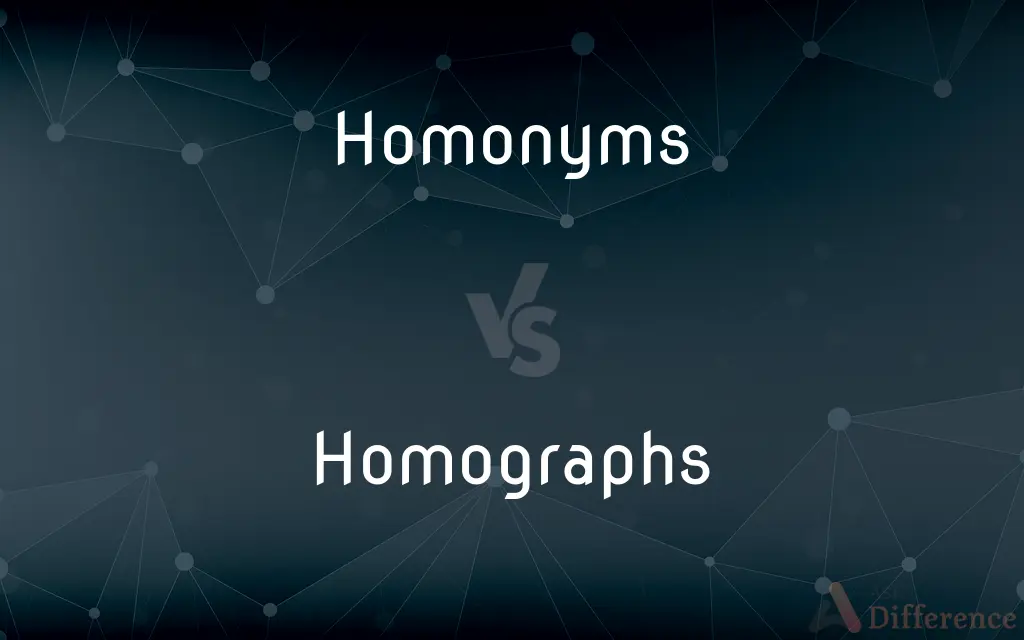Homonyms vs. Homographs — What's the Difference?
Edited by Tayyaba Rehman — By Fiza Rafique — Published on December 30, 2023
Homonyms are words that sound alike but may differ in spelling and meaning, while Homographs are words that share the same spelling but differ in meaning.

Difference Between Homonyms and Homographs
Table of Contents
ADVERTISEMENT
Key Differences
Homonyms are fascinating components of the English language, encompassing words that sound the same. These words, despite their phonetic similarities, can have different spellings or meanings. For instance, "pair" (a set of two) and "pear" (a type of fruit) are homonyms. On the other hand, Homographs create intrigue due to their identical spellings, but with varied meanings and sometimes different pronunciations. An example would be "lead" (to guide) and "lead" (a type of metal).
Homonyms can lead to confusion because they sound identical. This similarity in pronunciation means that context is crucial to discern the intended meaning. "Bare" (without covering) and "bear" (the animal) are homonyms, and understanding them depends on their use in a sentence. Conversely, Homographs might be pronounced the same or differently, which can also lead to misunderstandings. For example, "row" (a line) and "row" (a quarrel) are homographs.
While Homonyms primarily play on the ears, being auditory doppelgangers of each other, Homographs play with our eyes, appearing as visual twins. When reading aloud, Homographs can trip up the reader if they're unsure of the context. For instance, one might read "tear" (a drop from the eye) the same as "tear" (to rip), even though they are homographs with different pronunciations.
Understanding the difference between Homonyms and Homographs is essential for clear communication. Homonyms require listeners to use context clues to comprehend the intended meaning, given their identical sound. In contrast, Homographs require readers to do the same, given their identical appearance. For instance, "sewer" (a drain) and "sewer" (a person who sews) are homographs, making context key for comprehension.
In the study of English linguistics, both Homonyms and Homographs stand as testament to the language's richness and complexity. They demonstrate the multifaceted nature of words and meanings, urging learners and native speakers alike to be attentive to context. While Homonyms emphasize the phonetic aspect of language, Homographs underscore its visual facet.
ADVERTISEMENT
Comparison Chart
Definition
Words that sound alike but may differ in spelling and meaning.
Words with the same spelling but different meanings.
Example
"bare" vs. "bear"
"lead" (to guide) vs. "lead" (a metal)
Reliance on
Sound
Spelling
Pronunciation
Always the same
Can be the same or different
Context Importance
Essential for understanding due to same sound
Essential for comprehension due to same appearance
Compare with Definitions
Homonyms
Homonyms can have different meanings.
Bark (of a tree) and bark (sound of a dog) are Homonyms.
Homographs
Homographs are words that share the same spelling.
The word bow (to bend forward) and bow (a weapon) are Homographs.
Homonyms
Homonyms can confuse listeners without context.
Without context, plane and plain as Homonyms might be misunderstood.
Homographs
Homographs can hold different meanings.
Bass (a type of fish) and bass (low sound) are distinct Homographs.
Homonyms
Homonyms play a significant role in wordplay and puns.
She made a joke using the Homonyms mail and male.
Homographs
Homographs add depth to the written English language.
The Homographs content (pleased) and content (what's inside) enrich linguistic discussions.
Homonyms
Homonyms might have different spellings.
Flour and flower are Homonyms with different spellings.
Homographs
Homographs may have different pronunciations.
Tear (to rip) and tear (from the eye) are Homographs pronounced differently.
Homonyms
Homonyms are words that sound alike.
The words sea and see are Homonyms.
Homographs
Homographs can create confusion when reading.
Without proper context, the Homograph lead could be read incorrectly.
Homonyms
One of two or more words that have the same sound and often the same spelling but differ in meaning, such as bank (embankment) and bank (place where money is kept).
Homographs
One of two or more words that have the same spelling but differ in origin, meaning, and sometimes pronunciation, such as fair (pleasing in appearance) and fair (market) or wind (wĭnd) and wind (wīnd).
Homonyms
A word used to designate several different things.
Homographs
Plural of homograph
Homonyms
A namesake.
Homonyms
(Biology) A taxonomic name identical to one previously applied to a different species or other taxon and therefore unacceptable in its new use.
Homonyms
Plural of homonym
Common Curiosities
What are Homonyms?
Homonyms are words that sound alike but may differ in spelling and meaning.
How do Homographs differ from Homonyms?
Homographs are words that share the same spelling but can have different meanings.
Which requires more attention to context: Homonyms or Homographs?
Both require context for clarity, Homonyms in speaking and Homographs in reading.
Why are Homographs confusing?
Homographs can be pronounced differently or hold varied meanings, confusing readers without context.
Is it common for English to have many Homonyms and Homographs?
Yes, English is rich with both Homonyms and Homographs due to its diverse linguistic roots.
Can a word be both a Homonym and a Homograph?
Yes, some words, like "lead", can be both Homonyms and Homographs based on different pairs of words.
Are there any tools to help identify Homonyms and Homographs in texts?
Dictionaries and linguistic software can often help identify and clarify Homonyms and Homographs.
Are Homonyms always spelled differently?
Not always. Some Homonyms, like "read" (present) and "read" (past), are spelled the same.
How can I determine the correct meaning of a Homograph?
Using context and sometimes pronunciation can help discern the intended meaning of Homographs.
Why is it important to understand Homonyms and Homographs?
Comprehending both aids in clear communication and reduces misunderstandings in both spoken and written forms.
Are Homonyms more common in spoken or written English?
Homonyms are most noticeable in spoken English due to their identical sound.
Can Homographs always be identified by their spelling?
Yes, Homographs have the same spelling, but their meanings and sometimes pronunciations differ.
Can Homonyms or Homographs exist within the same sentence?
Absolutely! For example: "The bass player dropped his bass in the river," where "bass" is a Homograph.
Do other languages have Homonyms and Homographs like English?
Yes, many languages have their versions of Homonyms and Homographs, although the specifics vary.
How can I best teach the difference between Homonyms and Homographs?
Use examples and emphasize the auditory aspect of Homonyms and the visual aspect of Homographs.
Share Your Discovery

Previous Comparison
Chloroform vs. Carbon Tetrachloride
Next Comparison
Money Market vs. Capital MarketAuthor Spotlight
Written by
Fiza RafiqueFiza Rafique is a skilled content writer at AskDifference.com, where she meticulously refines and enhances written pieces. Drawing from her vast editorial expertise, Fiza ensures clarity, accuracy, and precision in every article. Passionate about language, she continually seeks to elevate the quality of content for readers worldwide.
Edited by
Tayyaba RehmanTayyaba Rehman is a distinguished writer, currently serving as a primary contributor to askdifference.com. As a researcher in semantics and etymology, Tayyaba's passion for the complexity of languages and their distinctions has found a perfect home on the platform. Tayyaba delves into the intricacies of language, distinguishing between commonly confused words and phrases, thereby providing clarity for readers worldwide.












































